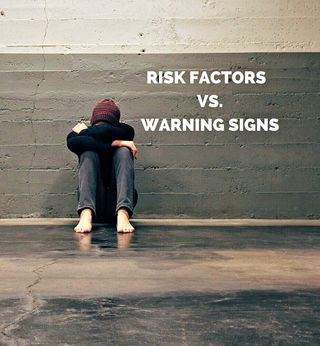Suicide
Risk Factors and Warning Signs for Suicide
How they differ and what they mean.
Posted September 18, 2017 Reviewed by Devon Frye

While there’s no single cause, suicide most often occurs when stressors exceed a child or an adult's ability to cope. Generally, untreated or undiagnosed mental health issues, particularly depression, greatly influence suicide.
But there are other aspects to consider and many people can find them challenging. Specifically, risk factors are often confused with warning signs of suicide. But the two are very different.
Warning signs indicate an immediate risk of suicide, whereas risk factors suggest someone is at heightened risk for suicide, but not necessarily in crisis.
Another way to understand these is simply this:
- Risk factors increase the probability a suicidal crisis will occur.
- Warning signs indicate a suicidal crisis has already begun.
How to Tell the Difference
Take the time to learn the signs that signal a friend or loved one is at risk for suicide. The American Foundation for Suicide Prevention suggests these three areas: health, environment, history.
Health factors
- Mental health conditions
- Substance abuse disorders
- Alcohol abuse disorders
- Serious or chronic health conditions
- Chronic pain
- Limited access to healthcare
- Sleeping difficulties
Environmental factors
- Stressful life events including death, divorce, separation, or job loss
- Prolonged stress factors including harassment, bullying, relationship problems
- Financial or school difficulties
- Access to lethal means, including firearms and drugs
- Exposure to suicide in the media or community
Historical factors
- Previous suicide attempts
- Family history of suicide attempts
- History of self-harm
- Recent hospitalization
- Cultural beliefs that support suicide
Now, familiarize yourself with signals that warn suicide may be imminent. The American Foundation of Suicide suggests these three areas: talk, behavior, mood.
Talk
- Being a burden to others
- Feeling trapped
- Talking about feeling hopeless and helpless
- Experiencing unbearable pain
- Expressing there's no reason to live
- Poor problem solving
Behavior
- Increased use of alcohol or drugs
- Accessing lethal means
- Acting recklessly
- Withdrawing from activities
- Isolating from family and friends
- Sleeping too much or too little
- Visiting or calling people to say goodbye
- Giving away prized possessions
- Hopelessness about the future
Mood
- Depression
- Loss of interest
- Rage
- Irritability
- Humiliation
- Anxiety
- Impulsivity
- Despair
- A sudden sense of peacefulness
How to Get Help
If you or a loved one experiences any risk factors, reach out to a mental health professional for help. National and global hotlines are also available 24 hours a day, seven days a week, to help you find support or care.
In the U.S., call 1-800-273-TALK or 1-800-273-5322.
If warning signs are present, it's vital to get immediate care. Calling 911 or going to the nearest hospital emergency room can be life-saving.
Worldwide, more people die from suicide than all the deaths caused by accidents, natural disasters, wars, and homicides around the world, combined. Eight out of ten people considering suicide give some sign of their intentions.
With knowledge and prevention, we can help those struggling with suicidal thinking find treatment, hope, and healing.


